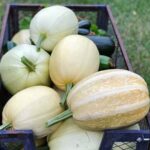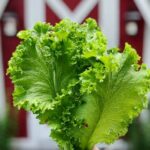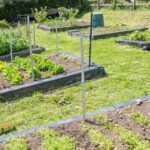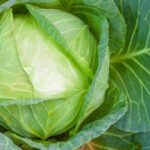Are you looking to make the most out of your limited garden space? In this article, we will explore the best vegetables for small gardens, offering tips and advice on how to optimize your space for a successful vegetable harvest.
Vegetables are an essential part of a healthy diet, and growing your own can be both rewarding and cost-effective. Whether you have a small backyard or only a balcony or patio, there are plenty of options for growing your favorite veggies.
Limited space doesn’t have to mean limited options when it comes to vegetable gardening. With the right selection of crops and some creative techniques, you can enjoy a bountiful harvest even in the smallest of spaces. We will discuss how choosing the right vegetables and utilizing techniques such as container gardening and vertical gardening can help maximize your yields while making the most out of your available space.
In addition to discussing specific vegetables that thrive in small gardens, we will also explore companion planting and other strategies for increasing yield in limited spaces. By the end of this article, you will have all the information you need to turn your small garden into a productive and flourishing vegetable paradise.
Choosing the Right Vegetables for Limited Space
When it comes to gardening in limited space, choosing the right vegetables is essential for a successful and bountiful harvest. While it may seem challenging to grow a variety of vegetables in a small garden, there are plenty of options that thrive in confined spaces. Whether you have a balcony, patio, or small yard, there are several factors to consider when selecting the best vegetables for small gardens.
First and foremost, it’s important to choose vegetables that are compact and don’t require a lot of room to spread out. Additionally, prioritizing high-yielding crops will help make the most of your limited space. Consider the climate and sunlight conditions in your area as well, as some vegetables require full sun while others can thrive in partial shade.
To make it easier for you to decide which vegetables to plant in your small garden, here is a list of top 5 vegetables known for their suitability in confined areas:
- Tomatoes
- Green Beans
- Radishes
- Lettuce
- Peppers
These vegetables can be easily grown in containers or small raised beds, making them ideal for small gardens. Plus, they offer delicious flavors and nutritional benefits that make them popular choices for home gardeners with limited space.
In addition to these popular picks, consider experimenting with dwarf or mini varieties of your favorite vegetables. These compact versions are specifically bred to thrive in containers and small spaces, making them perfect for urban or apartment gardening. By carefully selecting the right vegetables for your limited space, you can enjoy a thriving garden no matter how small your outdoor area may be.
Container Gardening
When it comes to gardening in limited spaces, container gardening is a popular and practical solution. It allows individuals with small gardens or even just a balcony to grow their own fresh produce without needing a large outdoor plot. Here are some tips for successfully growing vegetables in small spaces using containers:
1. Choose the Right Containers: Opt for containers that are at least 12 inches deep to allow for proper root growth. This can include pots, buckets, or even repurposed items like old tires or wooden crates. Just ensure that the container has drainage holes to prevent waterlogging.
2. Select the Best Vegetables for Container Gardening: Some vegetables are better suited for container gardening than others due to their size and growth habits. The best vegetables for small gardens include tomatoes, peppers, lettuce, radishes, and herbs like basil and parsley.
3. Proper Care and Maintenance: Container-grown vegetables require regular watering and fertilizing as they have limited access to nutrients compared to traditional garden beds. Additionally, be mindful of the container’s placement as sunlight is crucial for vegetable growth.
By utilizing container gardening, individuals with limited space can still enjoy the benefits of growing their own vegetables at home. With the right containers, suitable vegetables, and proper care, anyone can create a thriving mini-garden in even the smallest of spaces.
Top 5 Vegetables for Small Gardens
When it comes to gardening in limited space, choosing the right vegetables is crucial for a successful harvest. Whether you have a small backyard, balcony, or even just a sunny window, there are certain vegetables that are well-suited for small gardens. These vegetables not only thrive in confined spaces but also provide a bountiful yield, making them the best choice for small gardeners.
Tomatoes
Tomatoes are an excellent choice for small gardens due to their versatility and high productivity. They can be grown in containers or hanging baskets, making them perfect for limited space. With proper care and support, tomatoes can flourish in small gardens and provide you with delicious fruits throughout the growing season.
Herbs
Herbs such as basil, thyme, and rosemary are perfect for growing in small gardens. They can easily be grown in pots, window boxes, or even on a sunny kitchen windowsill. Not only do they add flavor to your dishes, but they also attract beneficial insects to your garden.
Peppers
Peppers come in various sizes and colors, making them a visually appealing addition to any small garden. They can be grown in containers or directly in the ground if space permits. Peppers thrive in warm weather and require minimal maintenance, making them ideal for beginner gardeners with limited space.
These top 5 vegetables for small gardens are just a few examples of crops that can thrive in confined spaces. By choosing the right vegetables and utilizing creative gardening techniques such as container gardening and vertical gardening, you can make the most out of your small garden and enjoy a bountiful harvest throughout the growing season.
Vertical Gardening
What Is Vertical Gardening?
Vertical gardening is a great solution for small garden spaces, allowing gardeners to make the most out of limited space by growing vegetables upwards instead of outwards. This method involves using structures such as trellises, arbors, or vertical planters to support the growth of vegetables, maximizing the use of the available space.
Benefits of Vertical Gardening
One of the key benefits of vertical gardening is that it allows you to grow a variety of vegetables even in a small area. By utilizing walls or other vertical structures, gardeners can grow plants such as peas, tomatoes, cucumbers, and even certain varieties of squash and melons without taking up valuable ground space. Additionally, vertical gardening can provide better air circulation and sunlight exposure for plants, leading to healthier growth and higher yield.
How to Start Vertical Gardening
To start your own vertical garden, it’s important to consider the specific needs of the vegetables you want to grow. Some plants may require specific types of support structures or trellises, while others may thrive in hanging planters or wall-mounted containers.
It’s essential to choose lightweight but sturdy materials for your vertical gardening setup and ensure that the structure is securely anchored to prevent any accidents. Lastly, be sure to regularly monitor and maintain your vertical garden by watering and providing necessary nutrients for your vegetables.
By implementing vertical gardening techniques and choosing the best vegetables for small gardens, you can effectively increase the productivity of your limited space while enjoying a bountiful harvest.
Tips and Tricks for Successful Vegetable Gardening in Limited Space
When it comes to successful vegetable gardening in limited space, there are a few tips and tricks that can help you maximize your harvest. One of the best ways to make the most out of a small garden is to choose the right vegetables for your space.
By selecting compact varieties and those that can be grown close together, you can ensure that every inch of your garden is being used efficiently. Some of the best vegetables for small gardens include cherry tomatoes, lettuce, and peppers.
In addition to choosing the right vegetables, proper spacing and planting techniques are essential for successful vegetable gardening in limited space. Utilizing techniques such as interplanting and succession planting can help you make the most out of your garden beds or containers. Interplanting involves growing two or more different types of vegetables in the same area, while succession planting involves planting new crops as soon as one is harvested to maximize production throughout the growing season.
It’s also important to pay attention to soil health and fertility when gardening in limited space. By using high-quality compost and organic fertilizers, you can ensure that your plants have all the nutrients they need to thrive in a small space. Additionally, regularly rotating your crops can help prevent soil depletion and disease build-up. With these tips and tricks in mind, even the smallest of gardens can yield an abundant harvest of fresh vegetables.
| Tips | Tricks |
|---|---|
| Choose compact varieties | Utilize interplanting techniques |
| Practice proper spacing | Pay attention to soil health |
| Select suitable vegetables | Rotate crops regularly |
Companion Planting
One of the key benefits of companion planting is that it helps to naturally deter pests and attract beneficial insects, thus reducing the need for chemical pesticides. For example, planting carrots with tomatoes can help repel pests that typically target these crops when they are planted alone. This not only saves space, but also promotes a healthier and more balanced ecosystem within your small garden.
In addition to pest control, companion planting also encourages efficient use of nutrients in the soil. For example, planting nitrogen-fixing plants such as peas or beans alongside heavy feeders like cucumbers or squash can help improve overall soil fertility and promote better growth.
With the limited space available in small gardens, maximizing nutrient efficiency is key to ensuring healthy and productive vegetable growth. When choosing the best vegetables for small gardens, consider incorporating companion planting strategies to optimize your yield while conserving space and resources.
Harvesting and Maintaining a Productive Small Garden
Maintaining and harvesting a productive small garden can be a rewarding experience for any gardener. It is important to keep your small garden well-maintained to ensure that your vegetables continue to thrive and produce a bountiful harvest. Regular maintenance tasks such as watering, weeding, and pest control are essential for the success of your small vegetable garden.
When it comes to harvesting your vegetables, timing is key. Different vegetables have different optimal harvest times, so it is important to pay attention to the specific needs of each plant. Harvesting at the right time ensures that you get the best flavor and quality from your crops.
One of the best ways to maintain a productive small garden is through companion planting. This gardening technique involves planting certain vegetables together in order to maximize space, deter pests, and increase yield. For example, planting tomatoes with basil can improve the growth and flavor of both plants. By utilizing companion planting strategies, you can make the most out of your limited garden space while also reaping the benefits of healthier, more abundant crops.
| Maintenance Tips | Harvesting Tips |
|---|---|
| Regularly water your plants, especially during hot weather. | Harvest leafy greens when they are young for a tender taste. |
| Keep an eye out for weeds and remove them promptly. | Use a sharp pair of scissors or shears to harvest herbs without damaging the plant. |
| Inspect your plants regularly for signs of pests and diseases. | Harvest root vegetables when they reach their mature size for optimal flavor. |
By following these tips and staying proactive in maintaining your small garden, you can ensure that you have a continuous supply of fresh, homegrown vegetables throughout the growing season. With proper care and attention, even the smallest garden can yield an impressive harvest of the best vegetables for small gardens.
Conclusion
In conclusion, growing vegetables in small gardens can be a rewarding and efficient use of space. By choosing the right vegetables for limited space and utilizing techniques such as container gardening and vertical gardening, gardeners can maximize their vegetable yield even in small areas. The top 5 vegetables for small gardens include tomatoes, peppers, lettuce, green beans, and radishes, all of which are well-suited for compact spaces.
Container gardening allows for flexibility in where vegetables can be grown, while vertical gardening makes use of wall space to expand growing area. These methods are especially useful for those with limited outdoor space or only a balcony or patio available for gardening. With some creativity and the right techniques, it is possible to have a thriving vegetable garden even in the smallest of spaces.
Companion planting is another strategy that can help maximize yield in small garden spaces. By planting compatible vegetables together, gardeners can benefit from increased pollination, pest control, and efficient use of space. Harvesting and maintaining a productive small garden involves regular care and attention to ensure that the plants continue to thrive. By implementing these tips and tricks, gardeners can make the most out of their small gardens with the best vegetables for small gardens.
Frequently Asked Questions
What Vegetables Should I Grow in a Small Garden?
In a small garden, it’s best to focus on growing compact and dwarf varieties of vegetables that don’t take up much space. Tomatoes, peppers, lettuce, carrots, radishes, and herbs like basil and cilantro are great options for small gardens.
What Vegetables Are Good for Small Spaces?
When dealing with limited space, it’s important to choose vegetables that are well-suited for small spaces. Some good choices include cherry tomatoes, bush beans, compact cucumber varieties, petite peppers, baby carrots, and mini lettuces. These veggies will thrive in a confined area.
What Vegetables Can You Grow in a Small Raised Bed?
A small raised bed can accommodate a variety of vegetables that are suitable for this type of gardening setup. Vegetables such as spinach, arugula, kale, Swiss chard, onions, garlic, strawberries, and even compact varieties of squash or zucchini are ideal for growing in a small raised bed.
The key is to maximize the space by choosing vegetables that don’t require a lot of room to spread out.

If you’re looking to get into vegetable gardening, or are just looking for some tips on how to make your current garden better, then you’ve come to the right place! My name is Ethel and I have been gardening for years. In this blog, I’m going to share with you some of my best tips on how to create a successful vegetable garden.





